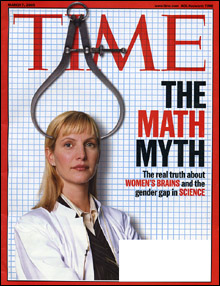“I think that certainly the newsweeklies, the business magazines, the technology magazines are looking at the kind of reinvention that every category that lives beyond 10 years has to do,” says the MPA’s Link.
Conversely, despite some concern about over-saturation and the quick shuttering of American Media’s Celebrity Living, magazines about the rich, famous, and frivolous — that often means Jessica, Jennifer, and Brangelina — remain a hot commodity. A report on WWD.com projected that People, Us Weekly, Star, In Touch, and Life & Style will combine to sell almost a half million more copies per week in the first quarter of 2006 than they did in the same period last year.

Floundering: Time
|
Among those publications that Husni selected as the industry’s 30 “most notable” 2005 launches are the star-studded OK!, Niche Media’s Capitol File (the Washington sister of the glitzy Boston Common, which debuted last September), and something called Hollywood Dog. (We’re not sure what to make of that one.)Even the more highbrow 02138, the Boston-based magazine bankrolled by Atlantic Monthly owner David Bradley, seems hooked on the power of celebrity and success. Targeting a high-end demographic — also the strategy of Boston Common — 02138 will lead its first issue with a list of the 100 most influential Harvard alum.
“We certainly know that celebrity is a very big category,” says Link. “Part of it may be escapism at a time when life is challenging and hard and difficult.” These “caption-oriented magazines” are tailored for readers suffering “from attention-deficit syndrome across the board,” adds Husni.
But before anyone mourns the apparent death of seriousness and heft, consider the New Yorker, where circulation climbed from about 948,000 three years ago to about 1,054,000 at the end of 2005. Or check out the recent success of the unflaggingly liberal and traditionally deficit-ridden 141-year-old journal of opinion, the Nation.
In the past five years, the Nation’s circulation has literally doubled to about 189,000. Revenue exceeded the $10 million mark for the first time in 2004. And last year, an impressive 40,000 readers subscribed via the magazine’s Web site.
“These kinds of magazines tend to do better in political opposition in Washington,” says Nation president Teresa Stack, noting that business has boomed since George W. Bush moved into the White House. But she says the recent upswing is “way bigger than anything we’ve ever seen” and attributes part of it to more-sophisticated marketing, frequent media appearances by editor Katrina vanden Heuvel, and a “robust” online presence.
Asked if a Democratic victory in the 2008 election might be bad for business, Stack insists, “That would be a happy problem for us.”
Good times/bad times
Next month, a magazine called Success — edited by former Mirabella editor in chief Gay Bryant — will roll out a 128-page inaugural issue that hopes to carve out a new niche in the beleaguered business category.
“We became convinced there was a big hole ... [to be filled by] a business magazine that addressed the personal side of business life,” says Bryant. “Conspicuous consumption is quite unappealing” in the post-9/11 world, she says. “The biggest issue people want to deal with is the work-life balance.”